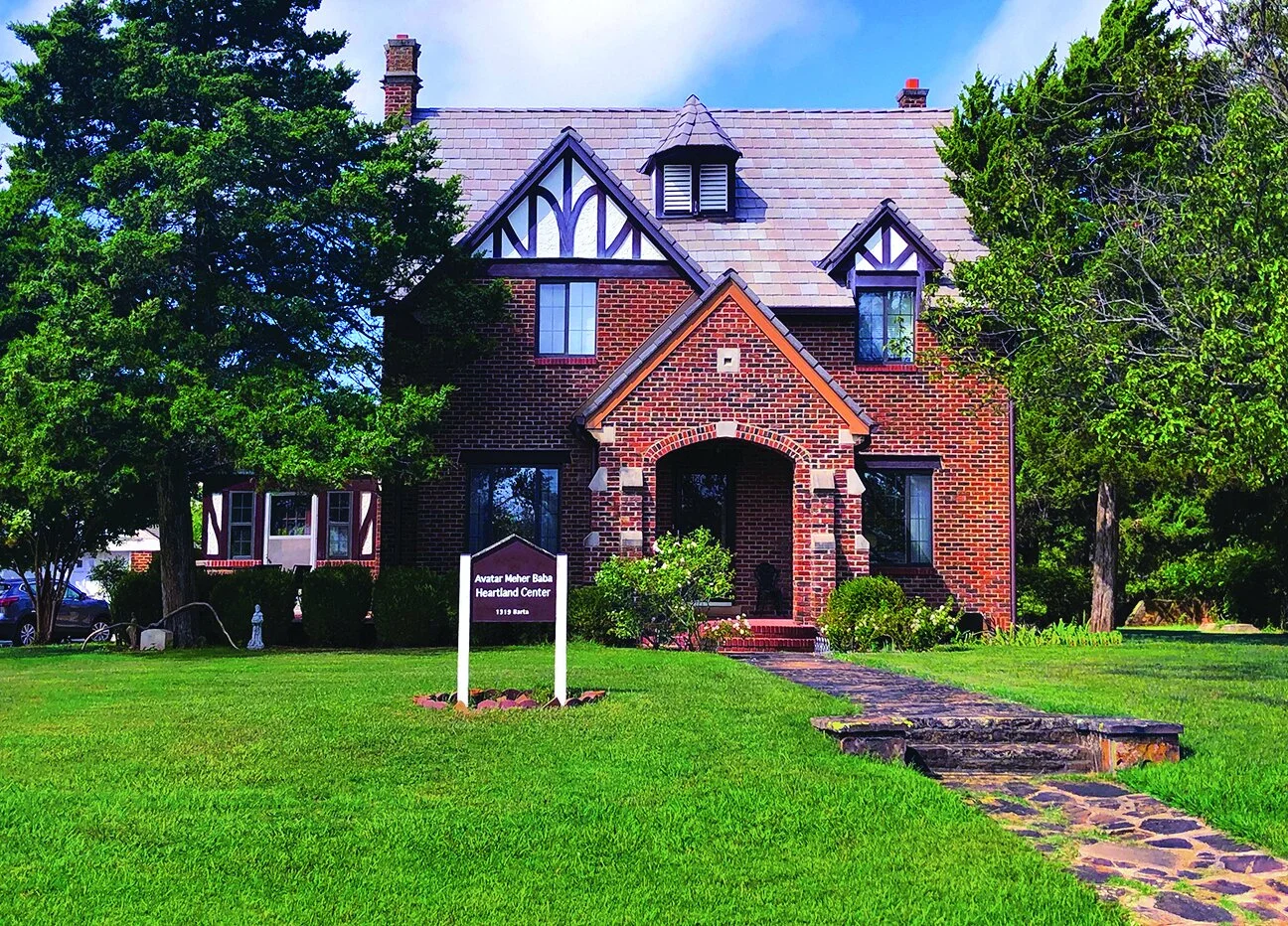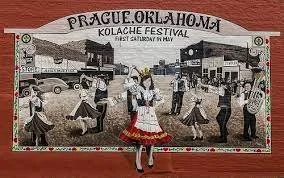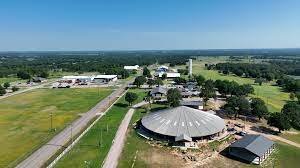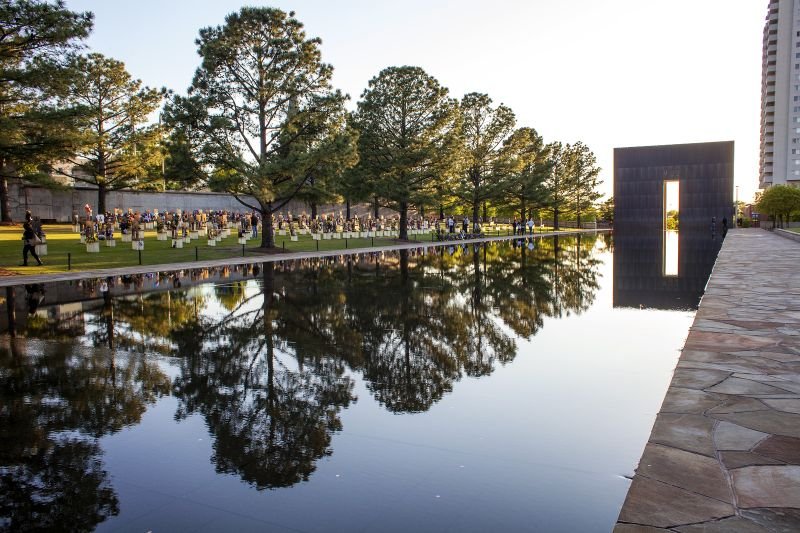VISITING THE HEARTLAND CENTER
Welcome!
Visiting Meher Baba’s sacred sites in Prague can be surprisingly easy to arrange. The closest airports in Oklahoma City and Tulsa are just an hour’s drive. The Heartland Center also provides a welcoming retreat atmosphere to make one’s visit comfortable and conducive to pilgrimage.
In this section you will find important information about:
The Burleson House with the Prague Regional Memorial Hospital in the background
Visiting the Sacred Sites
There are two sites in and around Prague associated with Meher Baba’s 1952 accident that are considered sacred to many who follow Him. Our caretaker can provide exact directions and give guidance and assistance on visiting both of these sites.
The hallowed ground where Meher Baba spilled his blood on American soil is located on the public roadside of Route 62. It’s 9.3 miles from the Heartland Center. By Baba’s Grace, and with the generous outpouring of support from His lovers worldwide, the Heartland Center has recently been able to purchase the land which adjoins it. We are now in the process of developing a memorialization plan and we will keep you updated. In the meantime, Baba lovers will now be able easily visit the accident site with guidance from our wonderful caretaker Jane Montgomery.
Meher Baba’s Accident Site
Site of Meher Baba’s accident
The room where Meher Baba recovered after His 1952 accident is located in the Prague Regional Memorial Hospital, which is directly behind the Heartland Center. Over the years, hospital staff have referred to it as “the prayer room” and warmly welcomed Heartland Center visitors. Because of recent administrative changes, Baba’s room has been converted to an office containing confidential files. In keeping with the hospital’s heartfelt respect for visiting pilgrims, they have graciously provided a private alcove nearby to place Baba’s photo and several chairs. In this way, visitors can continue to enjoy the atmosphere of Baba’s compassionate presence, which permeates the entire hospital.
Meher Baba’s Hospital Room
Meher Baba’s hospital room
The nearby alcove
Planning Your Stay
The Heartland Center currently is comprised of two neighboring historic homes, the Burleson House and the Morrison House. Both can accommodate overnight guests as well as day visitors. Each also has a well-equipped kitchen for visitors to prepare their own meals.
Reservations can be made with our welcoming, full-time caretaker Jane Montgomery at 919-619-1624. We want to make every effort to accommodate you during your trip so please give advance notice if possible.
Jane can facilitate trips to the sacred site of Meher Baba’s 1952 accident as well as to the dedicated space within Prague Regional Memorial Hospital where Meher Baba recovered for 12 days. A donation of $30 a night is suggested for each overnight guest.
The Burleson House in the spring
Accommodations
The Burleson House
The Burleson House is the former home of Dr. Ned Burleson, the compassionate doctor who attended to Meher Baba, Mehera, and the other mandali members injured during the 1952 accident. Built in the 1920s with Art Deco accents, the Burleson House has two guest rooms, a living room, formal dining room, full kitchen, and library. Both overnight guests and day visitors can enjoy the library and other shared rooms as well as peruse artifacts associated with Meher Baba's life and teachings. Our full-time caretaker, Jane Montgomery, also resides there and is available for assistance.
Burleson House Accommodations
The Morrison House
The Morrison House, also built in the 1920s, is the former home of Walter Morrison. Known affectionately as “Speedy,” he was one of Dr. Burleson’s dearest friends and was a steadfast supporter of the hospital founded by the doctor several months before Meher Baba’s accident. The Morrison House has three bedrooms, a living room, a formal dining room, and a full kitchen. There is also a lovely front porch which adds to the comfortable, tranquil atmosphere.
Morrison House Accommodations
Meals
Both the Burleson and Morrison houses have full kitchens and plenty of cabinet space for guests who would like to prepare their own meals. Groceries can be bought nearby at Harps, a local store that also offers delivery service. Communal meals are prepared on occasion.
There are several local restaurants, cafes, and bakeries in Prague. Don’t miss out on having a kolache (pronounced KOE-lah-cha), one of Prague’s famous Czech pastries. Made with a soft, buttery pastry with a fruit filling on top, they’re not to be missed!
A communal meal at the Morrison House
Meher Baba’s Directives
The Heartland Center has adapted Meher Baba's directives regarding visitors to retreats established in His name. We hope these guidelines will also help ensure the safety and comfort of all Heartland guests.
Meher Baba’s Directives:
There is to be no use of illegal or non-prescription drugs, or involvement with such drugs, including marijuana. Meher Baba has said, “Drugs are harmful physically, mentally, and spiritually.”
No alcohol, including beer, is to be brought into or taken at the Center.
Divining cards, the Ouija Board, and I Ching are not to be used at the Center.
Please remember that Meher Baba does not wish us to indulge in conversations regarding backbiting, politics, or drugs
Meher Baba
Travel
Book a Flight
The closest airport to Prague is Oklahoma City’s Will Rogers World Airport which is a one-hour drive to the Center. The Tulsa International Airport is an hour and a half away. Some visitors may prefer to fly to the Dallas Fort Worth International Airport which is a larger airport that can be more affordable. The drive to Prague from Dallas takes about 3 hours.
Transportation from the Airport
Visitors will need to arrange transportation to the Heartland Center from the airports in Oklahoma City and Tulsa. Car rentals, ride-sharing services (Uber/Lyft), taxis, and shuttles (from Oklahoma City) are available.
Plan a Road Trip
Since the Heartland Center is located directly in the heart of America, it makes for an exciting road trip from all points of the country. Please contact us if you are interested in following the same route taken by Meher Baba from the Meher Spiritual Center to Prague and need more information.
Visiting Prague
The town of Prague, Oklahoma calls itself “A small town with a BIG heart” and has a culturally diverse history, heavily influenced by both Indigenous and Czech cultures.
For close to two centuries, the vast area that is now Oklahoma was known as "Indian Territory.” In the 1830s, Native American tribes were forcibly removed from their ancestral lands in the Midwestern and Southeastern United States. Some Indigenous people settled in and around the area that is now Prague, most notably the Sac and Fox Nation.
The immense suffering and loss experienced by the people of the Cherokee, Muscogee (Creek), Seminole, Chickasaw, and Choctaw nations, among others, when they were forced west in the oftentimes deadly journey is known as the "Trail of Tears.”
Part of Meher Baba's 1952 journey to Prague paralleled and intersected this same route, as depicted in the map below:
This mural welcomes visitors to Prague
Brown line Trail of Tears route. Meher Baba’s route in white; His stops marked with hearts.
The indigenous tribes in the area have a long and rich history with cultural traditions that are still celebrated and honored today.
Sac and Fox Nation Pow Wow 2019 Jim Thorpe Memorial Park
In the early 20th century, a wave of Czech immigrants played a pivotal role in shaping the history of Prague which was named after the capital of Czechoslovakia. To distinguish it, residents call it “prā g” with a long “a” instead of “präg” with a short “a.” The town has retained its Czech identity and become a hub for Czech culture, which is reflected in its architecture, community events, and the establishment of Czech heritage museums.
The Kolache Festival in May celebrates Prague’s Czech heritage
Enjoy the variety of detailed exhibits and explore the history of Prague and its people. Don’t miss the exhibit on Meher Baba’s accident and Dr. Ned Burleson, the beloved town doctor who treated Baba and the mandali after the accident in Prague.
Exhibit on Meher Baba’s 1952 Accident
National Shrine of the Infant Jesus of Prague:
The shrine was founded by Czech immigrants and is visited by many thousands of pilgrims every year. Visitors can attend religious services in its beautiful chapel and take in the serene atmosphere of the surrounding gardens. The story of the miraculous infant Jesus of Prague holds a deep connection to the town's heritage and is located at 501 N. Jim Thorpe Blvd, Prague, OK 74864.
A statue of the infant Jesus of Prague in the Burleson House.
Visit the memorial to Jim Thorpe, considered one of the most versatile athletes of modern sports. A member of the Sac and Fox Nation, he was born in a log cabin just outside of Prague. Thorpe was the first Native American to win an Olympic gold medal for the United States. In the 1912 Summer Olympics, Thorpe won the gold medal in the classic pentathlon and a second gold medal in the Decathlon. He also played professional football, baseball, and basketball. The memorial is located at 809 N Jim Thorpe Blvd, Prague, OK 74864-4522
The Jim Thorpe Memorial
Local Events and Festivals
Mark your calendars for the annual Kolache Festival which happens the first Saturday of every May. A sweet roll with a fruit-filled center, kolaches are a traditional Czech dessert.
Check the Prague Chamber of Commerce for other upcoming events, festivals, or fairs.
Parks and Outdoor Recreation
Prague City Park is located in town and features playgrounds, picnic areas, and walking trails.
Wes Watkins Reservoir, a short drive away, offers fishing, boating, and hiking opportunities. Prague Lake is a popular spot for fishing. Check local regulations for fishing licenses and any restrictions.
Golfing
Enjoy golf at the Prague Golf and Country Club, a 9-hole public course located at 1112 N Ayars Ave in Prague. Green fees are $10 a day for 9-holes during the week and $12 on weekends. (Seniors are $9 a day, $10 on weekends.) Cart rental is $5 a day per person for 9 holes. There’s an Honor Box if the clubhouse is closed.
Route 66
Prague is situated near historic Route 66. Drive north on Jim Thorpe Boulevard (Highway 377) toward Stroud for 18 miles. Route 66 intersects as you enter Stroud. Head east on Rte. 66 toward Tulsa or west toward Oklahoma City to experience the more rural aspects of the famous highway.
Visitors to the Heartland Center are encouraged to immerse themselves in the area's vibrant culture and to extend the same warmth and hospitality to the people of Prague that they have generously shown us.
Exploring Beyond Prague
The Jim Thorpe Home and Museum
Located in Yale, OK, the Jim Thorpe Home is a free museum open to the public for tours and is full of artifacts of the Thorpe family. The famous American Olympian lived in this 2-bedroom house from 1917 to 1923 and is the only house Jim Thorpe ever owned. The house was built in 1915 and had cold running water, electricity, sewer, and gas, which was unusual for that time period. The interior still contains many of Jim Thorpe's personal belongings and artifacts. The home is open to the public Wednesday - Saturday from 9 am - 5 pm. Visit at 706 E Boston, Yale, OK 74085.
Jim Thorpe’s Home is in Yale, OK
Seminole Nations Museum
The Seminole Nation Museum in Wewoka is about half an hour from Prague. It documents and interprets the history and culture of the Seminole Nation of Oklahoma and the people and events that make its capital, Wewoka, one of the most historically significant and culturally diverse communities in Oklahoma.
Aerial of the Seminole Nation Museum
The John Hope Franklin Center for Reconciliation
Located in Tulsa, the Center offers exhibits and educational programs that delve into the legacy of racial and cultural divisions, promoting understanding and unity. Visitors can participate in guided tours, attend workshops, and experience thought-provoking discussions aimed at fostering dialogue and healing. The center also features a memorial garden and the Reconciliation Park, providing reflective spaces for contemplation. You can schedule a tour that includes information on the 1921 Tulsa Massacre, Greenwood Historic District, Black Wall Street, as well as African American and Native American migration.
Memorial to John Hope Franklin
Oklahoma City National Memorial Museum
Located at the site of the 1995 Oklahoma City bombing, this museum serves as a poignant tribute to the lives affected. The memorial grounds feature striking symbolism, including the "Field of Empty Chairs," each representing a life lost, and the Survivor Tree, a testament to resilience. Visitors can also explore the tranquil Reflecting Pool. Through interactive exhibits, artifacts, and personal stories, visitors gain a comprehensive understanding of the events leading up to the bombing, its aftermath, and the resilience of the community. The museum provides a solemn yet impactful journey, offering insights into the significance of remembrance, unity, and the healing process.
The memorial’s reflecting pool
Oklahoma History Center
The Oklahoma History Center, also located in Oklahoma City, is a 215,000 square foot learning center exploring Oklahoma’s unique history of Native culture, pioneers, aviation, commerce, and more. The Oklahoma History Center Museum is a Smithsonian Affiliate and is accredited by the American Alliance of Museums.
Atrium at the Oklahoma History Center
First Americans Museum:
This museum which opened in Oklahoma City in 2022, showcases the rich heritage, history, and contributions of Native American communities. Through engaging exhibits, interactive displays, and authentic artifacts, visitors can explore the stories, traditions, and contemporary life of the first peoples of North, Central, and South America.
The arch’s open hand symbolizes welcome
National Cowboy and Western Heritage Museum
The National Cowboy and Western Heritage Museum is known as America’s premier institution of Western history, art, and culture. It features numerous exhibits, galleries, and events. Of particular interest is the sculpture at the entry of the museum: “The End of the Trail” (pictured below). The magnificent iconic statue standing at the entry of the museum signifies a Native American and his horse, both weary in body and spirit, at the end of their journey. This sculpture was first conceived in 1894 (Baba’s birth year) and was installed in the museum in 1969 (the year that Baba dropped His body).
“The End of the Trail” was first conceived in 1894
Reservations
To make an inquiry or a reservation please contact our caretaker Jane Montgomery at 919-619-1624.
You can also submit the form below and we will get back to you as soon as possible.


































